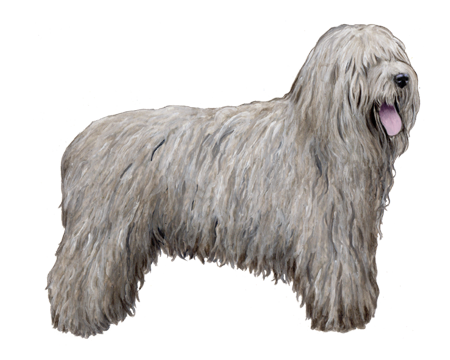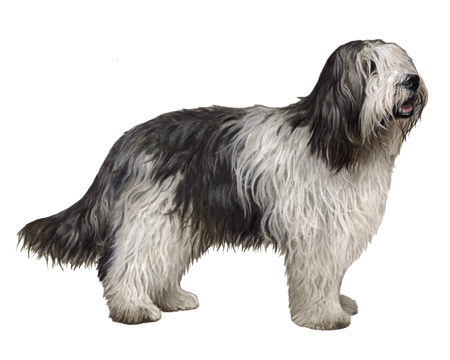
Australian Shepherd
The Australian Shepherd is an intelligent, driven working dog with strong herding and guarding instincts. These high-energy, athletic dogs also make loving, affectionate companions for active families.
Interested in discovering if your dog is an Australian Shepherd?
Check out Wisdom Panel's DNA tests.

Australian Shepherd Traits
General Appearance
The Australian Shepherd is a medium-sized dog with a solid build, well-balanced proportions, and a smooth, free gait. Males are masculine without coarseness, and females are feminine but not slight of bone.
Coat and Colouring
Australian Shepherds are a double-coated breed with a unique trait: The undercoat varies in quantity with variations in climate. Their outercoats are of medium length and texture, and straight to wavy in appearance. The hair is short and smooth on their heads, ears, front of forelegs, and below the hocks while the backs of the forelegs and britches have moderate feathering. Australian Shepherds have moderate manes and frills that are more pronounced in males.
The breed comes in several coat colors: black, blue merle, red merle, red (all red or red with or without white markings, and/or tan points). There may be white on the neck, chest, legs, muzzle underparts, and blaze on the head. Australian Shepherds with blue merle or red merle coloring tend to become darker with age.
Distinctive Physical Traits
Australian Shepherds have solid, muscular bodies with straight, strong backs and deep chests with well-sprung ribs. Their almond-shaped eyes may be brown, blue, amber, or other variations or combinations of these colors—and often include flecks and marbling. Their ears are moderate size, triangular-shaped, and set high on the head. Australian Shepherds have naturally bobbed tails.
Australian Shepherd Temperament
Although Australian Shepherds are serious about their work, the breed is known for having an even disposition. These are good-natured dogs that are seldom quarrelsome. Their intelligence, exuberance, and playful personalities make Australian Shepherds excellent companions.
Australian Shepherds are not the right fit for all families. Their strong herding tendencies could lead them to chase cars, corral children, or herd other pets. And despite their friendly natures, it can take time for Aussies to warm up to strangers.
These dogs do best in homes where there is room to roam and plenty of opportunities to engage in high-energy activities.


Australian Shepherd History
The Australian Shepherd did not get its start in Australia. The Basques, who lived in the borderlands between France and Spain, relied on Pyrenean Shepherds to work alongside their herds. In the 1800s, the Basques began migrating to Australia to keep sheep. Their Pyrenean Shepherds crossbred with other working dogs, including Collies and Border Collies, creating the modern version of the Australian Shepherd.
The Basques later immigrated to the United States (with their dogs in tow), and the breed became known as the Australian Shepherd. These fearless herding dogs fast became popular for their skill and stamina. They took their place as an iconic part of “cowboy culture” in the American West and still work on ranches and as rodeo performers.
Australian Shepherd Care
Nutrition
Feed Australian Shepherds a high-quality dog food that is appropriate for their life stage (e.g., puppy, adult, senior) and consider a diet formulated for active breeds. These high-energy dogs are not known for becoming overweight. Still, portioning out their food with a measuring cup and limiting treats to no more than 10% of their daily calories can help keep Australian Shepherds fit and trim.
Grooming
Australian Shepherds have waterproof double coats that require regular grooming. Brush them at least once per week to remove cast-off hair and, during spring and fall when these dogs blow their coats, brush them with an undercoat rake several times per week. Regular nail trims and ear cleanings should also be part of the grooming routine.
Like all breeds, Australian Shepherds benefit from regular dental care that includes at-home teeth-brushing and professional cleanings.
Exercise
Australian Shepherds are working dogs that prefer to be on the move. If there are no sheep or cattle to herd, these dogs will require lots of exercise. Aussies make great running companions and enjoy brisk walks, hiking, swimming, and trips to the dog park. These highly intelligent dogs also excel in dog sports such as agility, obedience, rally, dock diving, and—of course—herding.
Without adequate exercise, Australian Shepherds can become bored and destructive. Mental stimulation is essential, too. Provide Australian Shepherds with puzzle toys to help keep their minds engaged.
Training
Training is a must for this breed. Australian Shepherds are intelligent and keen to learn new things, which makes them excellent students. These dogs need guidance to overcome their territorial and overprotective instincts and channel their boundless energy in positive directions. Aussies love spending time with their owners and will see training as a bonding experience.
Focus on positive reinforcement and reward-based training. Avoid repetitive activities, which will cause Australian Shepherds to lose interest in training. Fast-paced games and activities are best to keep them engaged (and help burn off energy).

Australian Shepherd Genetic Health Conditions
-
Canine Multifocal Retinopathy 1
Canine Multifocal Retinopathy 1 (CMR1) is an eye disorder that can cause retinal decay which may impact vision, but very rarely results in blindness.
-
Chondrodystrophy (CDDY) and Intervertebral Disc Disease (IVDD) Risk
Chondrodystrophy (CDDY) is a skeletal disorder characterized by shortened limbs and abnormal early degeneration of the spinal discs, or intervertebral disc disease (IVDD), which predisposes to disc herniation.
-
Cone Degeneration (Discovered in the Alaskan Malamute)
Cone Degeneration (CD), also called "day-blindness" is an inherited eye disorder causing light-sensitivity (photophobia) and an inability to see in bright light.
-
Hyperuricosuria
Hyperuricosuria (HUU) is a condition that predisposes affected dogs to the formation of urinary stones, such as kidney or bladder stones.
-
Junctional Epidermolysis Bullosa (Discovered in the Australian Shepherd)
Junctional Epidermolysis Bullosa (JEB) is a skin disorder that causes skin fragility and blistering, as well as irritations in the oral cavity and upper digestive tract. The associated genetic variant has been identified in the Australian Shepherd.
-
MDR1 Medication Sensitivity
The MDR1 gene variant causes a defect to a drug pumping protein that plays an important role in limiting drug absorption and distribution (particularly to the brain). Dogs with the MDR1 variant may have severe adverse reactions to some commonly used medications.
-
Neuronal Ceroid Lipofuscinosis 8 (Discovered in the Australian Shepherd)
Neuronal Ceroid Lipofuscinosis 8 (NCL8) is a progressive disease causing uncoordinated movements, behavioral changes, vision loss, and epileptic seizures.
Knowing if your Australian Shepherd is a carrier or at-risk for these conditions can help you and your veterinarian plan for your pup's lifelong care. With Wisdom Panel™ Premium, you can get results for over 200 genetic health tests.
Breed Group
Herding
The herding group is a diverse category. These highly intelligent breeds were developed to guard and control the movement of livestock.
Resources
https://www.akc.org/dog-breeds/australian-shepherd/
http://images.akc.org/pdf/breeds/standards/AustralianShepherd.pdf
Reviewed 26 July 2020 by Laura Inman, DVM

































































